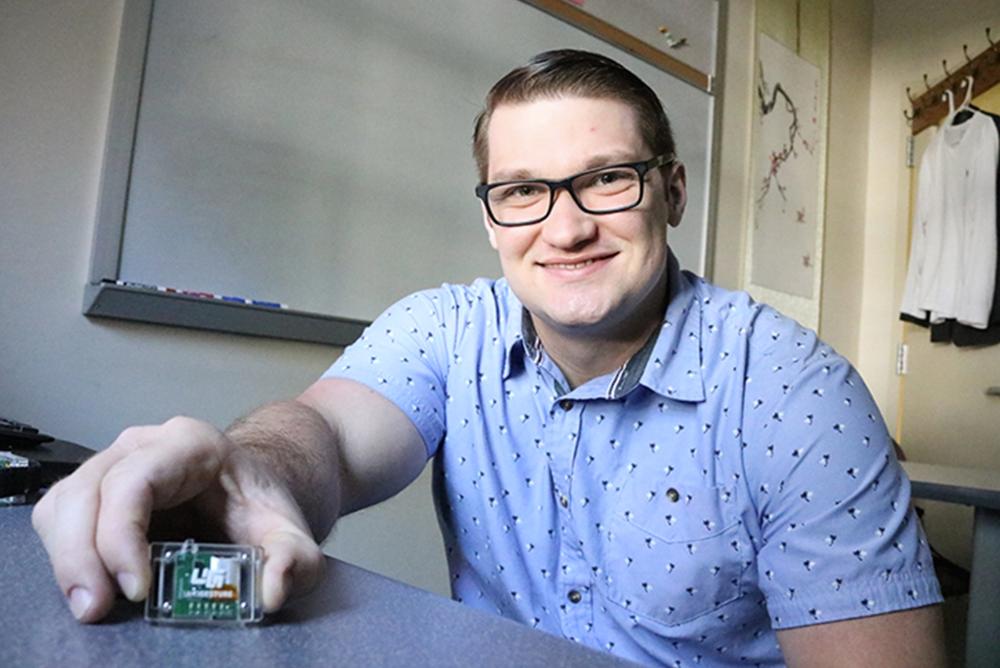Chemistry Events
[PAST EVENT] Dissertation Proposal - Kenneth Howard Koltermann, Computer Science

Abstract:
Over the past decade, ubiquitous sensing has been increasingly explored as a viable means collect patient health data to improve how doctors can diagnose neurological disorders and diseases. As machine learning methods continue to be improved by researchers from the computer science community, machine learning has seen a slower adoption by healthcare researchers to automatically detect and treat symptoms of neurological diseases such as Parkinson's disease. In this dissertation, I investigate how wearable computing and machine learning can be used to automatically detect and treat symptoms of Parkinson's disease (PD), freezing of gait (FoG) and hand tremors, in both real-time and offline settings.
First, we designed a FoG detection and treatment system, FoG-Finder, which combines ubiquitous sensing, mobile computing, and machine learning to automatically detect and treat FoG symptoms in real-time. We first created time and frequency domain features using domain knowledge about how FoG symptoms manifest. Then, we used a multi-input convolutional neural network (CNN) model on a smartphone for real-time inference of FoG/non-FoG gait. To evaluate FoG-Finder, we collected data from 11 (PD) patients consisting of 716 FoG events. FoG-Finder beat the previous state-of-the-art, obtaining a 13.4% higher F1 score and 10.7% higher overall accuracy compared with other validated real-time FoG detection and treatment systems in a leave-one-subject-out (LOSO) setting. FoG-Finder also obtained an average treatment latency of 427ms and 615ms for subject-dependent and LOSO settings, respectively, proving FoG-Finder to be a viable FoG detection and treatment system for real-world use by PD patients.
Second, we further improved real-time FoG detection by identifying that turns are the most common aspect of non-FoG gait falsely identified by prior FoG detection systems as FoG, leading to treatment application when it is not needed. To address this revelation, we designed the Gait-Guard wearable FoG detection and treatment system. The system generates hand-crafted features derived from domain knowledge about the various ways that PD patients can express turns during non-FoG gait, and uses a light-weight multivariate time-series transformer model capable of real-time inference on mobile hardware to detect FoG symptoms. We evaluated Gait-Guard on a dataset we collected consisting of 26 PD patients and a total of 1591 FoG events. Gait-Guard was able to obtain a FoG event accuracy of 96.5% with a reduction in the false positive treatment rate of 112% compared to prior real-time FoG detection works including FoG-Finder. Gait-Guard is demonstrated to work for real-time treatments with an average FoG detection latency of just 378.5ms in a LOSO setting.
Third, we are currently studying how real-time FoG detection models can be adapted to supply accurate FoG labels to automate the clinical FoG labeling process. We collected a FoG-rich dataset containing 41 PD patients while they walked through the five most common FoG triggering scenarios. We plan to combine a rules-based approach derived from domain knowledge about the FoG labeling process with machine learning to accurately provide start and end times to FoG time segments, something that no other research work has addressed.
Finally, we will explore how wearable computing and machine learning can automatically detect and treat PD hand tremor symptoms in real-time, and leverage the real-time inference of our machine learning models to supply accurate hand tremor labels to clinicians in an offline setting. This will further improve how PD clinicians can monitor and treat their patients. Overall, we utilized wearable computing and machine learning to facilitate the detection and treatment of symptoms of Parkinson's disease. Our results show that combining wearable computing and machine learning can improve how PD clinicians monitor and treat their patients.
Bio:
Kenneth Howard Koltermann is a Ph.D. candidate in the Computer Science Department at William & Mary, under the supervision of Prof. Gang Zhou. His research focuses on wearable computing and machine learning for healthcare. His Ph.D. research has been published in IEEE/ACM CHASE 2023 and 2024. He is a recipient of an Entrepreneur-in-Residence grant at William & Mary and is currently working on commercialization of his research through the startup Motion Medix LLC. He received his master's degree in computer science from William & Mary and his bachelor's degree in computer science from California State University, East Bay.
Sponsored by: Computer Science
